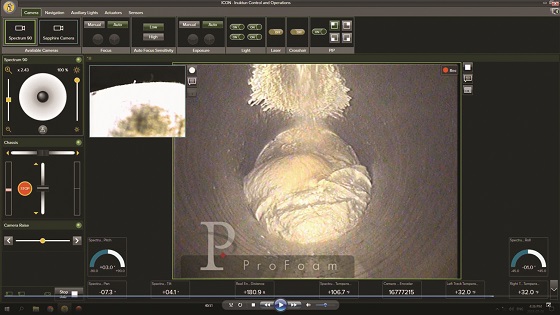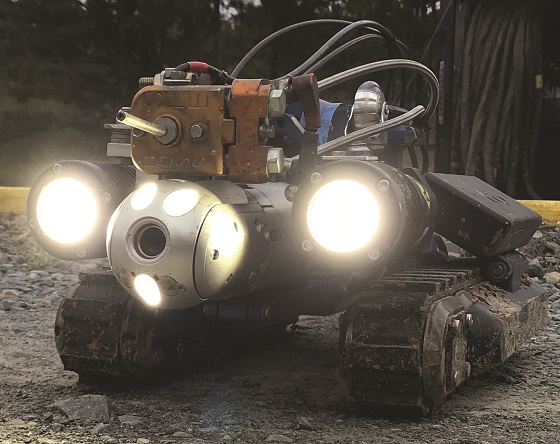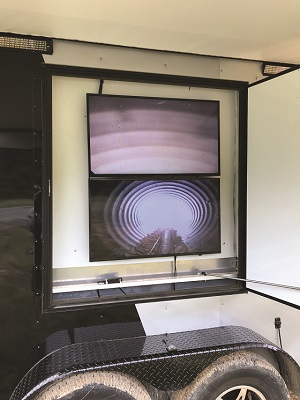A robotic spray-applied system utilizing rigid urethane foam could become an efficient solution to fill decommissioned energy pipelines, which would otherwise require consistent cathodic protection (CP) or the application of a more burdensome filler, such as grout, to prevent soil corrosion.
Based in West Monroe, Louisiana, USA, ProFoam LLC is a privately owned and operated construction contracting company that offers both specific and turnkey services for pipeline industry customers. Jeremy Smith, vice president of the foam contractor, says one consistent challenge for the pipeline industry over many years has involved the extensive requirements to handle decommissioned networks.
Historical Specifications
“DOT [U.S. Department of Transportation] will not allow the operating companies to pull CP off a pipeline until it is filled with something suitable,” Smith explains. “You’ve got lines that have been decommissioned for several years, and these companies are still spending money on CP, but they have no product flowing through. If they can fill it with a product, they can pull CP off.”
According to Smith, typical DOT specifications involve filling the pipe with something comparable to the ground pressure of dirt. Historically, one common filler has been grout. “DOT specifies that all your major roads have to be filled,” Smith says of requirements for pipelines that run beneath roadways.
“With using grout, most of the time, if you’re going to fill a road…you have to get on both sides of the road, dig a hole, cap it, plate it up, survey, and figure out which side is the high side to fill that thing up,” Smith says. This often requires having numerous concrete trucks at a project site, as well as making projections and assumptions on the amount of material that should be needed to fill a given underground segment.
“With concrete trucks, you know how much product you’re putting in, so you know how much should fill it up,” Smith explains. “But what happens if that pipe is a little bit longer in there [than you expected]? In that case, you didn’t fill it all the way up.”
Potential Alternatives
As its name would suggest, ProFoam specializes in foam-based offerings, which historically have also had a similar limitation when it comes to filling pipelines. “You know how much output you’re putting out of your [spray] gun, but you don’t have any eyes in there to tell you whether you filled the pipe up,” Smith explains. “You can't see it, so you're basically guessing.”

Given those logistical hurdles and the advent of newer technologies, Smith and his company began considering potential alternatives a few years ago. One particularly innovative solution for decommissioned pipelines was developed around the concept of combining foam with robotic spray systems. “That’s where technology is crucial,” Smith says. “If you can go in there with a robot, and everything is on video and you can look at it live and know 100% that it’s filled up…then when the operating company gets it, they have proof.”
Smith says he’s had the idea of combining foam for pipelines with robotics for some time. “We’ve had the idea for several years, but never had an actual project to go with it,” he notes. Previously, for pipeline jobs, the contractor usually pumped foam through smaller polyvinyl chloride pipe segments. “Trench work,” he calls it.
Smith says he first mentioned the potential of a robotic solution in 2014 and 2016 to a major U.S. pipeline operator (and longtime client), but they weren’t ready to commit to a new method at that time. In addition, some aspects of the necessary technology “weren’t quite there.”
But in 2018, when a new decommissioning project was specified for select segments of a historic U.S. pipeline network, the operating company was finally open to considering the new solution. And the technology was ready, too. “I pulled it up on my phone and showed the project manager what I was planning on doing,” Smith recalls. “He said, ‘If it works the way you say it is, this is excellent.’” The pipeline operator chose not to comment on the record for this story.
At the time, the foam contractor was still operating in the testing phase, Smith explains, since they had yet to receive a real-world project that would prove worthy of the significant investment to put it all together. “But once they saw the technology, they said ‘Yes, that’s right up our alley,’ because they want data behind everything they do.” From there, ProFoam collaborated with both material and equipment manufacturers to craft a solution.
On the material side, they selected the Elastopor rigid urethane foam system from BASF Corp. (Wyandotte, Michigan, USA) based on the manufacturer's in-depth experience with the pipeline industry. “BASF is probably our biggest supplier on the pipeline side,” Smith says. “CP is the biggest issue in our industry right now, and some foam companies don’t understand the whole CP concept. They know how to make foam or whatever product, but they don’t understand the whole deal. BASF is tied in full circle because of all the different products they have. They understand everything about the pipeline industry. When I need something, I can tell them what I need, and they can build a product specific to my needs.”
When ProFoam approached BASF with the idea, a team of polyurethane formulation scientists with the foam manufacturer went to work. “We developed a foam system specifically for pipe infill,” says Staci Wegener, market segment manager for the BASF Performance Materials division. “The product is designed for high-compressive strength to meet DOT requirements for under road application. It also has excellent flow with low exotherm to ensure that the polyurethane foam safely fills the entire pipe cavity.”
The Elastopor polyurethane system is a two-component product comprised of a resin blend and isocyanate, which react when combined to form a rigid polyurethane foam. For optimal product performance, the proper processing of foam components including ratios, mixing, and temperatures is critical.
Robotic Approach
But to accomplish the client’s complete goal of combining technical performance with data, the contractor needed to link polyurethane processing equipment with robotics. For this project, the contractor worked with robotics manufacturer Eddyfi Technologies (Québec City, Québec, Canada) and foam machine manufacturer Akurate Dynamics (Houston, Texas, USA) on the appropriate equipment to apply the foam. “It’s a two-part chemical,” Smith says of the foam. “It’s got to be one-to-one. In a situation like this, if you’re 500 feet [152.4 m] in the pipe and something goes wrong, you need a machine that will keep up. Akurate manufactures a machine [Delta CPS] that guarantees that you stay on ratio. It has a set of gear pumps and works off flow controllers.”

The CPS (chemical processing system) machine adjusts the user’s ratio to make sure applicators stay on ratio at all times. “Before they got into the foam business, they came from the oil and gas side,” Smith says of the company. “So, they understand a lot of what goes into it.” As such, the system was specifically designed for the application of plural-component polyurethanes and polyureas.
The final piece of the application puzzle was pairing the foam machine with the Versatrax 150 Mark II pipe inspection vehicle from Eddyfi. Available with up to 3,300 ft (1,005.8 m) of tether and options for entry into pipes as small as 6 in (150 mm), the vehicle allowed the contractor to combine the chemical processing system with an inspection camera and specialized control software. By using these tools, the foam’s installation is video documented via a remotely controllable camera with a raise motor, equipped with high-intensity light-emitting diode lights. This allows the camera to be repositioned on the fly during application or inspection.
 In the summer of 2018, the contractor combined those material and equipment technologies on segments of the historic pipeline system in Ohio and Pennsylvania. Specifically, the contractor was tasked with filling approximately 75 road sections ranging from 60 to 600 ft (18.3 to 182.9 m) in length. The original line was put in from 1942 through 1944 as a wartime line, with a pile that was uncoated due to the time period. “It was just bare steel pipe that didn’t even have a coating on it,” Smith recalls.
In the summer of 2018, the contractor combined those material and equipment technologies on segments of the historic pipeline system in Ohio and Pennsylvania. Specifically, the contractor was tasked with filling approximately 75 road sections ranging from 60 to 600 ft (18.3 to 182.9 m) in length. The original line was put in from 1942 through 1944 as a wartime line, with a pile that was uncoated due to the time period. “It was just bare steel pipe that didn’t even have a coating on it,” Smith recalls.
When compared to more traditional grout filling work, the foam solution had one immediate benefit. “With this foam and the way we’re applying it, it doesn’t matter which side of the road,” Smith explains. “You can go to the low side, the high side, or wherever it’s easy to get in. If it’s 20 feet [6.1 m] deep at the road, you can go back there where it might be only 5 feet [1.5 m] deep. You’re not having to create an environmental mess, because we can walk our robot right in. It’s a whole lot faster and less impactful, because we can take one foam rig and replace 15 concrete trucks. The lack of environmental impact is probably the greatest benefit of all.”
The general contractor would dig the pipe up and create a hole to where the foam contractor could get to the top of the pipe. “They’d cut us a slot to drop our robot in,” Smith explains. “Then when we would get through, they would weld that slot up and backfill.”
Rave Reviews
The pipeline segments were filled over about eight to 10 weeks in mid-2018, and the contractor says the reviews from the client were spectacular. “They absolutely loved it,” Smith says of the operating company’s response. “As opposed to having concrete trucks running everywhere, we could go in with one truck and one trailer. We set up, and we’re in and out. We literally did three or four roads per day.”
Best of all, the pipeline operator had the specific data that it needed. “Everything was done remotely and robotically,” Smith says. “It all goes back to a computer as live video.”
Based on the success of the initial project, the contractor has since been selected to apply the novel system to decommissioned pipelines of other major operating companies. “Every bit of foam going into a piece of pipe, you’ve got it on video,” Smith says of the system. “DOT, the operator, anybody that needs to see that the pipe is full of product, there’s a video. You’ve got complete video proof.”
Sources: ProFoam LLC; BASF, www.basf.com. Contact Jeremy Smith, ProFoam—e-mail: jeremy@profoamllc.com; Staci Wegener, BASF—e-mail: staci.l.wegener@basf.com.